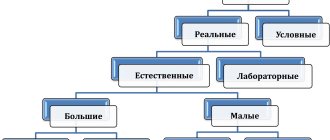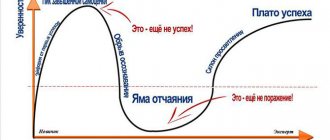Facilitation is a technique for conducting a friendly conversation with employees of a company. It takes place in psychology, pedagogy and other fields of science. In addition, facilitation has types, techniques and tools of work that guarantee positive results of its implementation.
Facilitation is an important tool for changing a company for the better
What is social facilitation
Facilitation is a term in psychology that includes tools, skills, and processes for effectively organizing group discussion of existing issues. The need for this phenomenon arose relatively recently; the main goal is to find some way to unite a group of people towards achieving an effective goal. Group facilitation is the process of discussing an issue with the help of a facilitator who explains the essence of certain points, helping to make a unanimous decision.
The facilitator is in itself a powerful tool in the facilitation process, which must have certain skills. Among them are:
- Ability to direct and structure discussions in the right direction.
- Selecting good ideas.
- Correctly achieving a psychological exit from your comfort zone in order to broaden your horizons.
- Working with diverse groups.
- Responding to and overcoming conflict situations and participants’ difficulties in conducting a conversation.
- A combination of different tools and techniques for working with a group.
- Elimination of stress.
- Openness to people, motivating personal changes.
Definition of a phenomenon in psychology
The definition of facilitation in psychology is interpreted as changing an individual’s behavior in the presence of strangers. If we consider it as a tool, the interpretation changes: it is a management model designed to facilitate communication. In contrast to facilitation, other techniques are more directive and strict. Thus, the usual flow of the meeting, when the boss gives out his own orders, is replaced by facilitation, which involves each member of the group in discussing further actions.
Note! Group members complete tasks with great enthusiasm.
The point is that the task assigned to them becomes exciting and unusual. In addition, in this case, one’s own contribution to the development of the organization is felt more acutely, which causes strong returns from employees.
The facilitator knows how to motivate employees to be fully productive at work
The psychological characteristic of the concept marks a special interest in the group in the role it can play in shaping the progress of the organization - this is social facilitation. It is noteworthy that a psychologist involved in establishing interaction and mutual influence among group members must be aware of the following: the final result may be positive, but an outcome cannot be excluded where facilitation will turn into an obstacle due to which the goals will not be achieved.
How is facilitation different from moderation?
Facilitation has much in common with the concept of moderation. The facilitator and moderator are invited interpersonal experts who aim to bring all group members together to make one actionable decision.
However, facilitation can be opposed to moderation in terms of the level of control. The moderator assumes more stringent boundaries and rules for conducting meetings. Facilitation allows the use of tables, sketches, even construction sets and toys to make the “lesson” more visual.
The methods are rightfully effective, although they can be used more individually. As an example, facilitation is given, which is more aimed at resolving conflicts, while moderation has an impact on problematic issues of the company as a whole.
Social facilitation and inhibition
Social facilitation is a phenomenon where one person improves his or her work abilities in the presence of other people. A facilitator is a person who facilitates the work task of an individual and helps to strengthen the performance of not only the group, but also the individual. Sociology itself comes down to studying the patterns of interaction and relationships between people. It is noteworthy that in the lives of animals there are high rates of effectiveness of actions. Thus, social facilitation is to enhance the performance of activities by monitoring the progress of the individual.
One of the mysteries of the method is how a person will react to outside control
This conclusion was reached by an American psychologist who drew attention to the fact that cyclists participating in a bicycle race with rivals showed better results than simply riding with a stopwatch. This means that the presence of strangers, especially competitors, forces an individual to be better at his work. Later it was discovered that this effect is achieved in solving simple problems. In the case of more complex issues, a person is characterized by inhibition - a decrease in a person’s performance under supervision.
Inhibition can occur for various reasons:
- fear of evaluation (as a result, a great fear of making a mistake);
- distractibility (the individual pays more attention to the reactions of others, but concentration on work dissipates);
- observer (who can become an irritant).
Social facilitation and laziness
A person, being in a group, “relaxes”, believing that his work does not matter. This can be described in a short term - laziness. Social loafing is a fairly common phenomenon and occurs in people who are used to working independently. The cultural factor plays a big role in this case. For example, Western types of people rely more on themselves; they are individualists. The Asian type is considered collectivist.
Overload theory
An alternative to the inhibition theory is the overload theory, according to which various distractions do not lead to an increase in arousal and the development of anxiety, but to an overload of the brain, which reduces the efficiency of its activity.
Moreover, in such a situation, an overabundance of information occurs in the area of working memory, and the person temporarily loses the ability to solve complex problems.
As a result of a stressful situation when performing actions in public, a person begins to worry, which leads to disorientation and the parallel emergence of multiple solutions, resulting in overload.
It is not possible to choose the right decision in such a state due to the lack of an adequate reaction of a confused person.
Types of facilitation
Personality disorder - what is this diagnosis?
Facilitation is divided into several types:
- Psychological. It is a management process during which the construction (or reconstruction) of a certain system occurs. Along with the ongoing personal changes, this process is considered probabilistic, nonlinear, and irreversible. Personality is known to be dynamic. Psychological facilitation has elements of paradoxical control over the process of self-organization of an open personality system.
- Pedagogical. This is a type of pedagogical activity during which the student realizes his self-worth. Studying is designed to support the individual’s desire for self-development, disclosure of abilities, and self-improvement.
- Sports. An important part of the sport, aimed at being able to unite all members of the team, while at the same time demonstrating their value as individuals.
A classic example of successful facilitation in sports
- Ecofacilitation. This type of facilitation is intended to convey to a person the understanding that he, as an individual, is an open dynamic system. This system is in constant interaction with the environment (but not only social and natural). The facilitator's task is to guide the client through so-called transformative processing.
Robert Zajonc's principle
Social psychologist Robert Zajonc, having become familiar with the topic of social facilitation, conducted several experiments and came to the following conclusion. During the process of social facilitation, a dominant response is aroused in people. Thanks to this increased arousal, people solve easy anagrams faster and solve simple problems more successfully.
When it comes to complex problems, where the correct answer is not always obvious, then excessive arousal increases the likelihood of error. Therefore, for more complex tasks, it is better to be in a calm state in order to successfully cope with them.
Facilitation techniques
Social maladjustment in psychology
The facilitator uses a number of specific techniques in his work. Among them are the following:
- Search for the future, or Future Search. This technology is practiced in cases where organizational units are interested in a strong basis for cooperation, as well as for creating a progressive future.
- Going beyond, or Work out. In this case, new ways of interaction are being developed, reducing bureaucracy, and improving business processes. The most important point is that the company achieves high results.
- Brainstorming, or Brainstorm. A common method of sharing information within a group to generate fresh new ideas.
- Polarization of Opinion, or Polarization of Opinion. It happens that the proposed topic of discussion is met with negativity. This technique is designed to eliminate this negativity by identifying a general forecast for the flow of the conversation.
- Open space, or Open Space. A method used in large groups when there is a need to answer a large number of questions in order to find a solution to a certain problem. This technique involves a step-by-step method:
- a leading question (what do you want, how to improve/get it, etc.);
- concentration on the conversation (what we have now);
- ideas directly (taking into account the opinions of each participant);
- grouping of ideas (each group is given a name);
- evaluation of ideas (includes constructiveness, efficiency, effectiveness);
- plan for implementing the final solution.
Impact on science
Inhibition in psychology is a significant decrease in the effectiveness of an individual’s actions due to the presence of other people nearby.
This phenomenon has not been fully studied to date and therefore increasingly attracts the attention of scientists who regularly conduct various studies in this area, checking and double-checking various aspects that influence the development and appearance of this phenomenon.
The last such study was conducted in 2014. It was devoted to studying the characteristics of social inhibition in healthy people, as well as in autistic people. The main conclusion of this study is the conclusion that inhibition cannot be considered outside the situations in which it manifests itself.
Reasons for the audience effect
Social environment - what is it in psychology
The audience effect is a familiar phenomenon characterized by the way one person's behavior changes in the presence of a stranger. It is believed that cases of positive or negative influence of a stranger on a certain individual arise due to general excitement.
Note! Increased arousal is a positive effect when an individual performs simple tasks, he is confident in himself and his work.
People feel the audience effect differently
Much more often people encounter negative influences when an individual is afraid of making a mistake, not being confident in solving a problem.
Facilitation is contrasted with moderation; these are two different concepts. Facilitation is more flexible in relation to conducting conversations with people. Therefore, it is often ordered for employees by company managers in order to unite them and explain the importance of teamwork for the growth of the organization’s success.
Negative affect due to the presence of others
Later, a number of experiments were carried out that showed opposite results. In some cases, co-performers interfered with their presence. Animals in the presence of other similar individuals moved more slowly through the mazes.
The distracting effect of observers was noticed when learning nonsense words, going through mazes, and solving complex examples.
Then scientists came to the conclusion that social facilitation only works in cases where a person has mastered a particular action well (for example, riding a bicycle).
Impact on team management techniques
When managing work teams, it is necessary to take into account the risks of the phenomena of inhibition and facilitation. Social psychology indicates that the degree of emotional development of the group itself plays a decisive role.
If the team is formed of self-sufficient individuals who know their work, then observing them (or one of them separately) will lead to facilitation and increased productivity (or increased efficiency).
When there are problems in a collective community, surveillance and control can only make the situation worse. In this case, it makes sense to observe the process only when employees increase their level and begin to feel more confident.
Search for the future or Foresight
This large group technique was developed by Marvin Weisbord . It is used when, with the participation of a significant number of people, it is necessary to obtain a picture of the future, a scenario for the development of a situation based on existing experience and past precedents. This pattern of events is the basis for civic assemblies in German communes, and is often used as a tool for organized and productive work.
No less effectively, this technique can be used in or “Foresight” has an important feature - it allows you to unite heterogeneous subgroups to develop a single solution, for example, employees, clients and suppliers. Their joint participation will have a positive impact on the quality of decisions made, as it will allow finding common ground of interests of each party in the strategy, goals and prospects of the enterprise.
The event typically lasts two to three days and is carried out in six steps:
- A retrospective look into the past within a horizon relevant to the group.
- Analysis of trends - global and local, positive and negative.
- Assessment of the current situation based on criteria selected by the group.
- Creating a joint vision of an attractive picture of the future.
- Formulating common goals - realistic or breakthrough.
- Making decisions and planning steps.
The advantage of this group work technique is the ability to bring together different, even polar, points of view and “create” the future in the present. The vision created in this way is based on the achievements of the past, which can and should be used in the future. This helps participants perceive the dream “without separation from reality” and believe in themselves.
Role Boundaries
- The facilitator is not a member of the group and has no say in group decisions.
- The role of a facilitator does not involve performing the tasks of a clerk, stenographer, logistician or other administrative functions.
- The facilitator does not mediate the relationship between the group and the broader context of the organization or other groups outside the organization.
- The facilitator does not perform arbitration functions; group members are independently responsible for resolving conflicts and building relationships.
- The facilitator is not responsible for the quality of decisions made and is not responsible for their implementation.
Business background
Recently, in the context of leadership and management of an organization, the acronym VUCA has become increasingly common, which stands for Volatility, Uncertainty, Complexity, Ambiguity. Business situations often contain all four aspects of this military term. Such an environment requires rapid response to events, decentralization of decision-making and maximum inclusion of people - both in developing the vision and in its implementation.
The live communication process rarely resembles glossy stock photos
Turning a company's challenges into its benefits requires completeness of information, group diversity, creative thinking, high involvement and the use of constructive conflict, which will inevitably arise in such conditions.
This is where facilitation comes to the rescue with a whole arsenal of approaches, tools and facilitator skills for conducting strategic sessions and operational meetings, brainstorming and process work.
Distraction
An alternative view of the question—the distraction/conflict hypothesis—is becoming increasingly popular. The hypothesis states that during any activity that is being observed, the individual's attention is torn between watching and monitoring the work being done.
Such mutual activity can increase arousal and increase or decrease work efficiency. It depends on whether the person has already encountered this task or not. In addition, the strength of the effect may depend on a number of factors.
Skill Examples
Like any other professional, a facilitator requires certain skills and type of behavior, tools and methods to organize his work:
- Listen carefully to and observe nonverbal messages from participants.
- Remember what was said and help the group accumulate information.
- Establish simple and clear communication between group members.
- Pay attention to similarities and differences in the statements made.
- Analyze and synthesize what was said, identify points of agreement and disagreement.
- Identify suggestions and bring them to the group's attention.
- Encourage constructive behavior and pay attention to non-constructive behavior.
- Create a model of effective behavior and demonstrate it by example.
- Facilitate the flow of feedback in a healthy manner between participants in the process.
- Correct accusatory and defensive forms of communication and other “toxins”.
- Work with individual behavior of group members based on feedback.
- Be patient with the internal dynamics and speed of the group.
- Increase trust within the group, in your role and in the chosen process.
- Pay attention to successes, reward efforts and encourage group members.
- Monitor and maintain the ecology of each person's boundaries.
How to help a group achieve better results
Nataliya Trenina
Jun 13, 2021 · 9 min read
This review article opens a series of materials from the Dojo Facilitation workshop. The goal of this program is to allow more people to communicate more easily and interact more productively. The great challenge and great benefit of this platform is to create a space for practice (“dojo”), using our natural knowledge and social interaction skills. This makes the workshop a springboard for subsequent development as a facilitator.
World Cafe
The World Cafe group work approach to implementing change was developed by Juanita Brown and David Isaacs . The open-ended methodology offers participants a high degree of freedom, brings people together into teams and releases their creativity.
“World Café” is perfect when a large number of participants need to exchange knowledge and experience on a chosen topic and collect maximum information, impressions, opinions and assessments. The result of such a scheme will be a general “picture of the world” obtained in a short time - a reflection of the situation in the minds of those present and a cross-section of the general opinion on the topic.
Work using this method is most often organized for two to three hours and even outwardly differs from other group work technologies. In the room (“Cafe”) there are tables covered with large sheets of paper on which you can write, draw, take notes, draw and record information in any other way. A moderator (“Host”) sits at each table at all times; the rest of the participants move freely between them when a new discussion circle is announced.
Information worthy of attention, ideas for solving problems and opinions are recorded by the moderator without fail. At the end of the next round of discussion, a sheet of paper with notes is attached to the table, and the moderator summarizes the past discussion and its results into a mini-presentation.
Each moderator informs the participants who come to his table about the best practices received from previous “guests of the Cafe”. After this, the newly arrived “guests” voice their ideas and proposals on the problem, making a contribution to the general discussion. This technique helps to generate a large number of ideas, immediately question them, and either refute them or accept them for further work.
Thus, a significant amount of knowledge and opinions of participants on the chosen topic is concentrated in one place. In addition, the discussion process in the World Café creates conditions for the simultaneous mutual intensive learning of participants - a kind of knowledge transfer that is a “side effect” of group work.
Participants in such an event must be disciplined enough to evenly distribute time between visits to different tables. Therefore, the facilitator of the entire meeting must strictly monitor the time and help those present move from table to table on time. A concentrated, rich discussion is the desired product for the organizers of the World Café, which means that the facilitator will have to work hard to tear participants away from the conversation.
Another important task of the facilitator here will be organizing the final part - presenting the results of the meeting to all tables. With a large number of participants, it will be difficult to collect and properly process all the findings. Therefore, high demands must be placed on the selection of moderators, their organizational and facilitation skills.
Examples of positions
During discussions, the facilitator can take a more or less active position. His active participation can be manifested as follows:
- Supports constructiveness.
- Takes you away from personal confrontations.
- Interested in the opinions of participants.
- Strives to understand the group's ideas and does not impose his own.
- Gives equal attention to all participants, not just leaders or active ones.
- Does not allow categorical assessments, condemnation, devaluation, arrogance.
- Adjusts or modifies the original plan as necessary.











